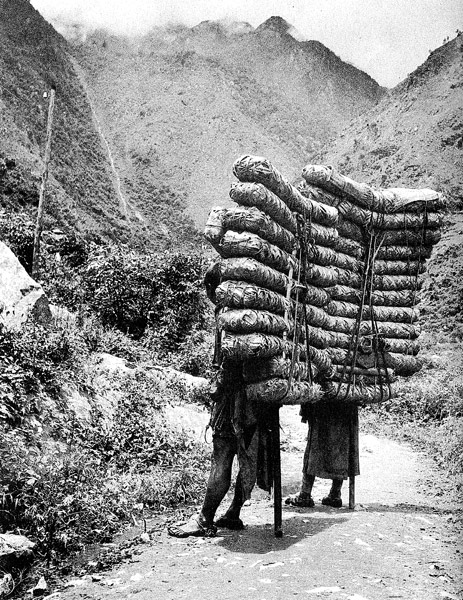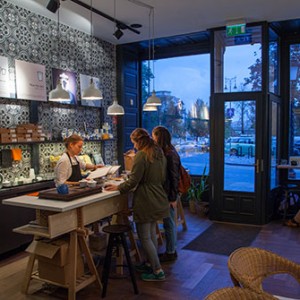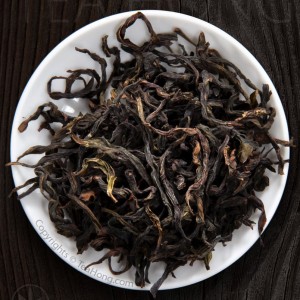Bulang Shengcha Pu’er
Bulang Shan ( Chinese: 布朗山 ) — Mountain of the Bulang people — is not very far away from the city of Pu’er by linear measurement. Only 244 km, much like Plymouth is from Gloucester in UK, same south-west to north-east relationship. In the old days, tea produced here was carried on foot or on donkey to the old trading post, which name has now become the name of all the shengcha and shu cha produced in Yunnan.
Yet in the old days when there were no bulldozers to build roads, the rocky, mountainous terrain in Yunnan was not exactly a stroll on the rolling meadows. Even less so when you have 135 kg ( about 300 lb ) of tea on your shoulders. Plus the weight of the straw and bamboo wrappings, and all the water they might have soaked up after a usual round of mid-day shower.
By the time the tea changed hands for horses or mules, or other provisions, the leaves would have had quite a lot of induced post-processing changes, even they had not been darkened before the journey began.

It was reported that the average porter carried 16 sacks of cha bings. There were 28 ( i.e. 7 x 4 ) bings to the sack. each bing weighed half a catty ( about 302g ). That makes 135.5 kg ( 298 lb ) net weight of tea to the porter.
The luxury of enjoying a shengcha a few thousand kilometres away from such Xishuangbanna regions as Bulang is really possible after roads have been built for these remote places. While I am not sure if it really takes only 3 hours to drive from Plymouth to Gloucester, like what Google says, 3 hours from Bulang takes you only to the nearest new town, Jinghong, about one third of the way to Pu’er ( Google is very wrong in that ). The roads in the mountain are narrow, winding, very rough, and unpaved. It really is hard for me to understand how in the past porters were able to do those trips, wearing only straw sandals or bare-footed, when roads were minimal.
Bulang is the sub-region that includes such famous origins as Banzhang ( Chinese: 班章 ) and Man’e ( Chinese: 曼峨 ). Productions from these old tea mountains can be fetching really high prices.
Although the market is hot, even so many years after the pu’er price crash, for the compressed form of this tea, I prefer the loose leaf. Technically speaking, the loose leaves are maocha. They were only preliminary dried for transporting to the compressing factory. Those that will transform into the discus ( cha bing ) or brick ( cha zhuan ) will be very briefly steamed, compressed and baked for further dryness. By the book, the final should be no more than 6% water content.

One reason for the complexity of the tea taste generally in Yunnan is its huge diversity of tea cultivars, the taxonomy of which has yet to be developed by specialists. This is one special red leaf cultivar in the Bulang area.
The loose leaves, however, do not go through that. They are somewhat like by-products of the whole shengcha puer trade, though they are no lesser tea than the more expensively compressed and wrapped counterparts. The degree of dryness varies from batch to batch dependent on the subjective decision of the tea master at the leaf collection point where most of the maocha processing takes place. Usually they are about 10%, i.e. dry and quite brittle to the grasp.
From my experience, this is perfect for storage maturing. Since we cover the topic of maturing in other articles, I shall talk about the tea’s taste now.
Enjoyed when the tea is still quite fresh, say within 3 years of production, shengcha from Bulang usually is quite distinctive with certain bitterness and briskness. A top quality one can be quite silky, sweet and complex with a good length. Generally, all better quality shengcha are very quenching and crisp, a lot more than most green tea. That from Bulang is much more so.
The tea’s strength allows it to hold good length in taste when mature, which, under normal conditions, can be about 20 years. The nice thing about pu’er is that you can get a scoop of it anytime through its storage without much effects on how the tea will mature.

Old woman plucking off a tea tree just steps away from home. Such tea trees, not particularly huge and so I guess not particularly old, are scattered everywhere in the region. They are also the key production tea trees for most higher price puer shengcha, as well as that for the farmer’s own use. In old tea gardens, they are in small groups, dotted by some larger ones and flanked by some smaller ones. Typical waist level bushes in terraced gardens are still the major bases for the majority of the region’s total throughput, though.
Like all shengcha pu’er, that from Bulang is cold by TCM nature. In addition to that, it is also quite strong to the stomach. As I have always advised, for those who are weak in yin energy, those who are immediately before or during menstruation, and those who have weaker stomachs, please use this tea with restrain and only occasionally.
It is however, an effective antidote when you are over stuffed, needing a push, or too restless. Do not use this tea when you already have had too many late nights though. That is because your yin energy would have been weakened already and this will further undermines it.
The cold TCM character tones down as the tea matures and becomes a good tea for going with meals. As with all shaper teas, such as partially oxidized Sri Lankan or Nepali, or Phoenix oolongs, a shengcha puer is great to drink with honey for strengthening immune against colds and flus.











